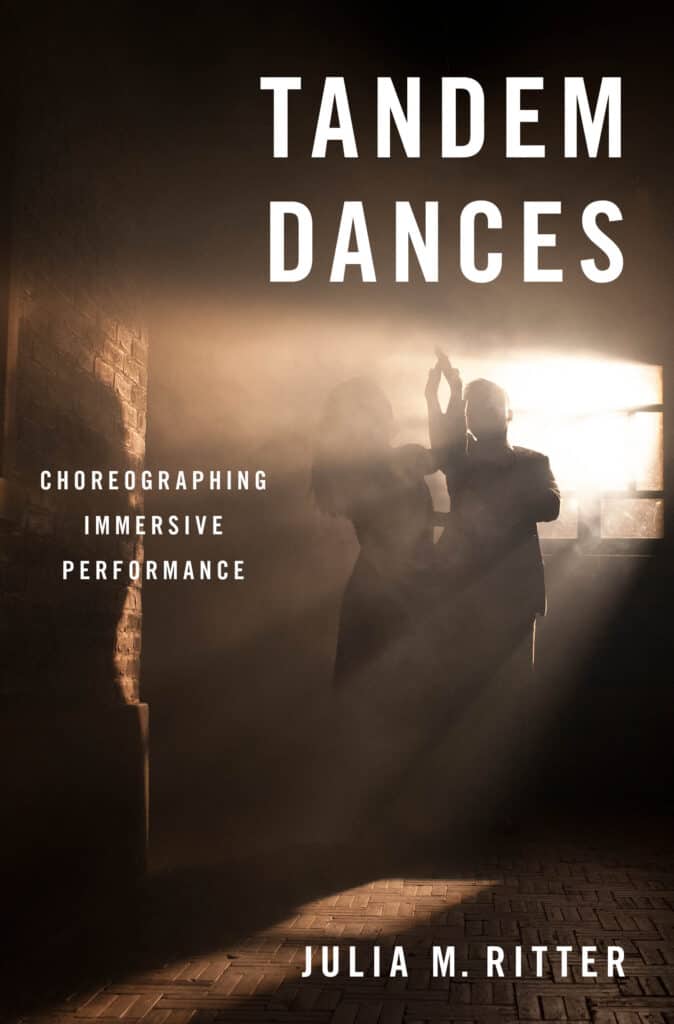Writing & Research
Prioritizing the study of dance and choreography through interdisciplinary approaches, with an emphasis on audience experiences and participatory, immersive arts practices.
New Book: Tandem Dances
Published by Oxford University Press, Tandem Dances: Choreographing Immersive Performance, is a book-length study exploring the contributions of dance to the creation and reception of immersive performance. Featuring the insights of choreographers, artistic directors, dancers, and spectators of various critically acclaimed and commercially successful productions from across the United States, as well as in Canada and the United Kingdom, the book directs dialogues in the fields of dance, theatre, and performance studies towards examination of choreography as an indispensable component of interdisciplinary creation.

Book Chapter - Forthcoming
Mixing Methods for Performance Research. Edited by Tracy C. Davis and Paul Rae and under contract with Cambridge University Press.
Reflecting on experiences of mixing methods in the interdisciplinary research of dance, choreography, immersive performance/participatory performance, and fandom, this chapter treats the research process as itself a compositional one that emerges in ‘tandem’ with the work being researched. These methods include: audience research, authoethnography, sensory ethnography, choreographic analysis, participant observation, SPaR (Spectator-Participation-as-Research, following the work of Deirdre Heddon, Helen Iball, Frances Babbage), and analysing media content. The aim of the chapter is to make the research process explicit so other researchers might apply a similarly compositional approach in audience research in other performance contexts.
TDR/The Drama Review (2017)
“Fandom and Punchrunk’s Sleep No More: Audience Ethnography of Immersive Dance.” Published in TDR/The Drama Review (Winter 2017), New York University and MIT Press.
Fan blogs devoted to Punchdrunk’s long-running immersive production of Sleep No More (SNM) demonstrate how audiences are reflecting upon and processing the highly sensory, nonverbal, and choreographic experiences they encounter during performances by channeling their postperformance perceptions into “visual ethnographies” that include forms such as digital painting, illustration, collage, and sculpture. When shared online, these works of fan art contribute to knowledge about SNM and reveal the impact of dance and immersive practices on spectatorship.


CHAPTER IN ANTHOLOGY (2016)
“In the Body of the Beholder: Insider Dynamics and Extended Audiencing Transform Dance Spectatorship in Sleep No More.” Published in Reframing Immersive Theatre: The Politics and Pragmatics of Participatory Performance, edited by James Frieze, 43-62. London, United Kingdom: Palgrave Macmillan.
Drawing upon interviews with Maxine Doyle, associate artistic director and choreographer of the UK-based Punchdrunk company’s immersive production of Sleep No More (SNM) as well as reflections of SNM performers and spectators, Julia M. Ritter considers how dance practices are deployed to affect experiences of immersive performance by engendering and complicating agentive actions, engagement, and investment in dance spectatorship.
JOURNAL ARTICLE (2015)
“Danse en tandem: Étude du mouvement des spectateurs et des performeurs dans Sleep No More de Punchdrunk.” Published in Revue Tangence: Engagement du spectateur et théâtre contemporain, under the direction of Catherine Bouko et Hervé Guay. Quebec, Canada: 108, 51-76.
The UK-based Punchdrunk company has created several immersive theatre productions since its founding in 2000, which begs the question of why Sleep No More (SNM)—Punchdrunk’s immersive production presenting the drama of Shakespeare’s Macbeth through dance—has been a long-running critical and commercial success. Drawing upon statements from Maxine Doyle, choreographer and associate director of SNM as well as reflections from performers and spectators of New York City performances between 2012-2015, Julia M. Ritter suggests that the success and popularity of SNM as a work of immersive theatre is due in large part to the ways in which dance has been conceptualized and centralized as a methodology intended to facilitate spectator experiences.


